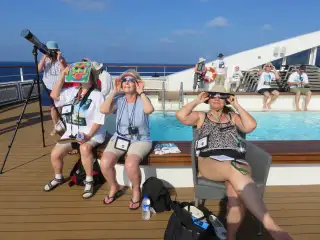Meet the People Who Spend Thousands Chasing Eclipses Around the World

On Aug. 21, the continental U.S. will experience its first total solar eclipse since 1979, and it’s going to be big — the astronomical equivalent of Beyonce announcing her twins or the Chicago Cubs winning the World Series.
This event is being billed as the "Great American Eclipse" and its "path of totality" is the 70-mile-wide swath where the moon will completely cover the sun for a couple of awe-inspiring minutes. The sky goes dark, the temperature drops and the sun's ghostly corona shimmers from behind the moon's dark silhouette. And unlike the most recent eclipses, this one will sweep the entire country, from Oregon down to South Carolina, where most Americans will be able to experience it within less than a day’s drive.
Experts are now predicting this eclipse will birth a whole new generation of eclipse chasers, echoing the last big boom in eclipse fandom - 1970, when a total solar eclipse travelled up the East Coast and hooked a generation of baby boomers on eclipses.
“Millions and millions of young people will be seeing it, and I've never heard of any one who walked away from their first eclipse and didn't say, 'holy cow, when is the next one?',” says Rick Brown, 64, a commodities trader from Long Island, N.Y. who has seen 15 total solar eclipses since his first in 1970.
Total solar eclipses happen roughly once every 16 months somewhere in the world, and people who have experienced one say they’re like episodes of Game of Thrones: it’s nearly impossible to stop at one. But chasing them around the globe can get pricey. “If you’re going to be an eclipse chaser, by definition you’re going to have to spend some money,” says Rick Fienberg, press officer of the American Astronomical Society.
The next total solar eclipse will happen on July 2, 2019 and will cross from the South Pacific Ocean into Chile and Argentina in South America. TravelQuest International, a Prescott, Az.-based company that specializes in astronomical travel, is running a "Cruise to Totality" from June 26 to July 10 to take passengers to view the eclipse over the South Pacific. A berth in the least expensive stateroom starts at $7,900 per person through Aug. 31, with those rates rising to $9,295 after that. “Make your plans early,” says Aram Kaprielian, president of TravelQuest.
Stephen Bedingfield, a retired civil servant from Yellowknife, Canada, did just that. He and his wife booked a high-end balcony cabin for the TravelQuest cruise. “Nothing like sitting on your balcony while passing idyllic atolls,” Bedingfield wrote in an email. He and his wife will pay roughly $28,000 for their excursion, which includes all cruise fees plus airfare to Tahiti and a couple night’s accommodation there before the cruise.
“I know some people who go into revolving cycles of debt to see eclipses,” Bedingfield says. To avoid the same predicament, he plans ahead and budgets.
The good news is, advance planning is easy when it comes to eclipses. The highly predictable orbits of the sun, moon and earth mean that astronomers know many years out exactly when the next eclipses will occur. In fact, all of the eclipses within the lifetime of everyone alive now can be forecasted down to the second, says Glenn Schneider, an astronomer at the University of Arizona who has experienced 33 total solar eclipses since his first in 1970, when he was 14 years old.
“These things take you to exotic places,” Kaprielian says. In addition to the physical beauty, he notes that eclipse chasers are drawn to — well, the chase. Even if you're in the right spot at the right time, cloudy conditions could prevent you from viewing the eclipse as it happens, and Mother Nature gives no repeat performance. "There's an element of suspense and drama," Kaprielian says.
Eclipse chasing has meant picking and choosing for Bill Kramer, now 59, especially before he retired at age 50. During the years he owned his own computer business, he’d sometimes skip eclipses that interfered with his daughters’ school, or ones in particularly rainy months like April; he might still pass on eclipses in punishing terrains. “In 2015 there was one that went across the Artic region, where there’s more polar bears than humans,” Kramer says about a recent one he decided to skip.
But he’s been to plenty total solar eclipses and visited most continents in the process. He'll be watching the Great American Eclipse, his 17th total eclipse, from the border of Kentucky and Tennessee; he and his wife made their hotel reservation — some 20 rooms for family and friends — more than a year ago. “Maybe for the two years prior you don’t go to Disney or New York City or somewhere else expensive on vacation,” Kramer says. “We’ll go camping and hunt our own dinner.”
Like others in his cohort, Kramer experienced his first eclipse in 1970. “I skipped out of a swim meet in my Speedos in March to watch it,” Kramer says.
Eclipse chasing may involve some expenses around traveling, but unlike other hobbies, it doesn’t involve pricey gear. While some people spring for nice camera gear to document the event, the only thing you really need is a pair of viewing glasses that cost only a few dollars. (NASA has tips on eclipse safety and a list of approved vendors that make safe glasses.)
Glasses are essential to view the partial total eclipse that leads up to and then follows the moment of totality, Schneider says. If you’re in the path of totality, you should watch the moment of totality with your naked eyes.
“You’ve got to get into the path of totality,” Schneider says. “The difference between that and the partial eclipse is literally between night and day. We’re all thinking the next generation is waiting to be hatched.”